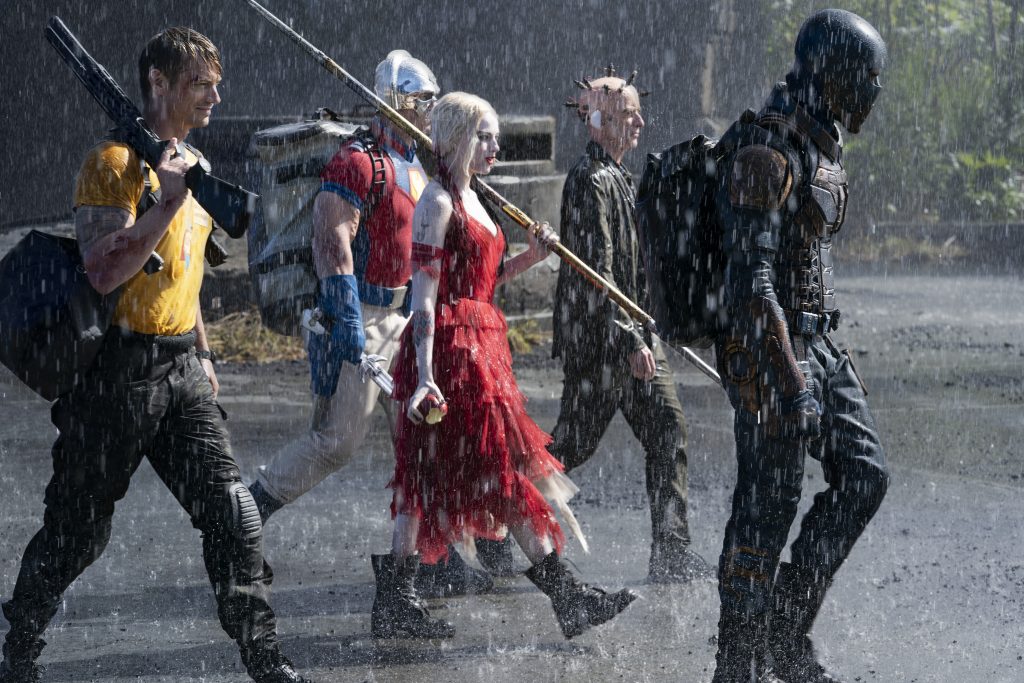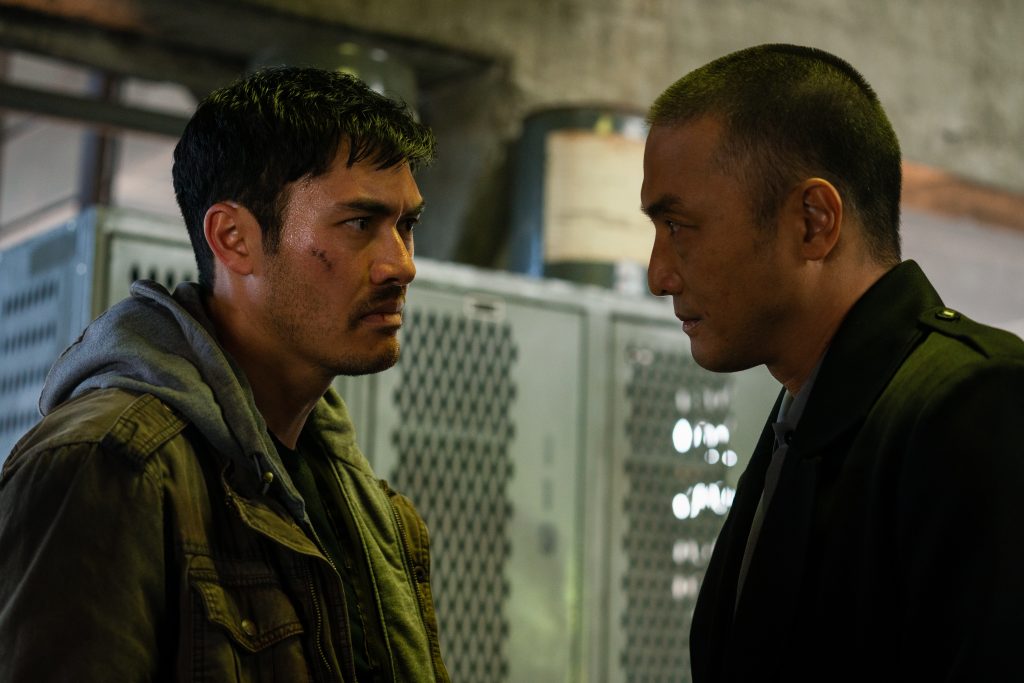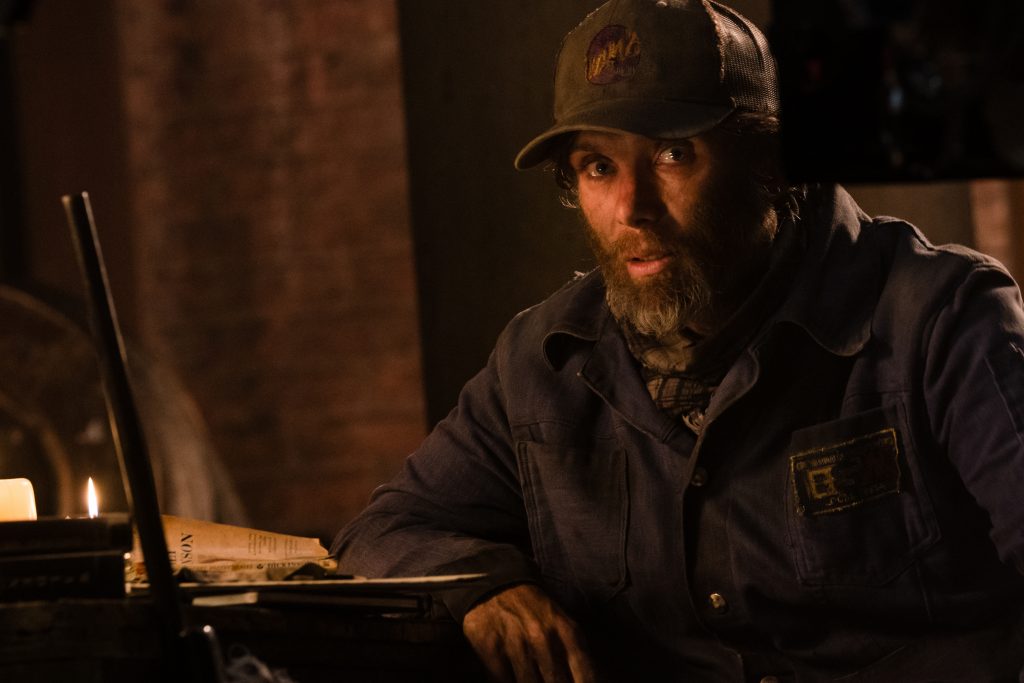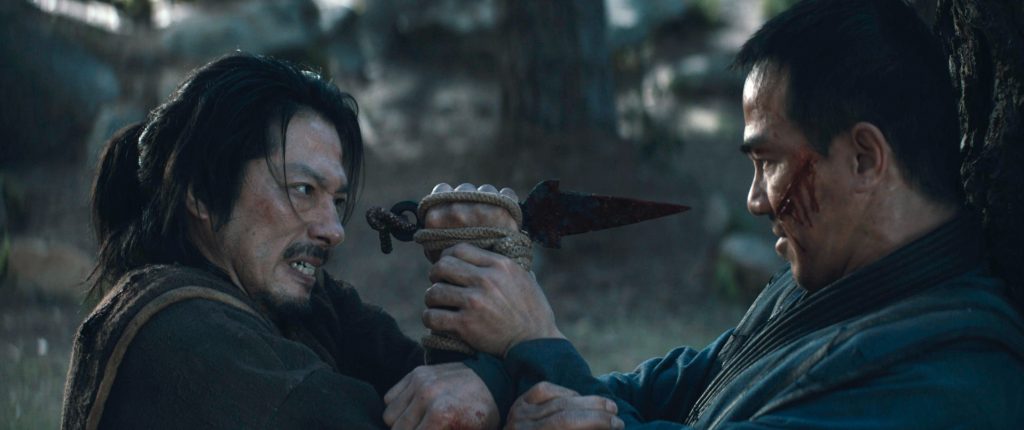July 30, 2021
by Carla Hay

Directed by James Gunn
Culture Representation: Taking place in Louisiana and a fictional South American country called Corto Maltese, the superhero action flick “The Suicide Squad” features a racially diverse cast of characters (white, black, Latino and Asian) representing government officials, superheroes, villains, fantasy creatures and everything in between.
Culture Clash: The Suicide Squad—a ragtag group of prisoners and outlaws with special abilities—is ordered by the U.S. government to go on a secret mission to destroy a nefarious scientific operation that is intended to control the world.
Culture Audience: “The Suicide Squad” will appeal primarily to people who are interested in violent, zany and foul-mouthed superhero movies that skillfully blur the lines between heroes and villains.

“The Suicide Squad” is the bonkers and bloody action spectacle that fans of iconoclastic superhero movies deserve. It’s a worthy and memorable alternative of writer/director David Ayer’s 2016’s much-maligned “Suicide Squad,” which was a confused and muddled film that ultimately played it too safe for these roguish and rude DC Comics characters. “The Suicide Squad” (written and directed by James Gunn) gives a much-needed adult-oriented resuscitation—not just to the original “Suicide Squad” movie but also to the superhero genre in general, which has a tendency to be formulaic and predictable.
“The Suicide Squad” is the superhero movie equivalent of someone who will kiss you and kick you at the same time. Within the first 15 minutes of the movie, there are surprises that most superhero movies would never dare to have. Several characters initially look like they’re going to be prominently featured in the story, but they actually get killed off early in the film. And there are more unexpected deaths that defy the usual expectations of who lives and who dies in a typical superhero film.
Because of all these unexpected deaths in “The Suicide Squad,” the only way to describe the movie without giving away spoiler information is to say that the Suicide Squad’s mission in this movie is to go to the fictional South American island nation of Corto Maltese and destroy a top-secret scientific operation called Project Starfish. Just like in 2016’s “Suicide Squad” movie and in the DC Comics series that inspired this movie franchise, the Suicide Squad (whose official name is Task Force X) consists of dangerous inmates who are held at a federal prison called Belle Reve in Louisiana. The members of the team have special skills or powers that make the Suicide Squad an above-average combat group.
Belle Reve is a recruiting center for a no-nonsense, tough-talking U.S. government official named Amanda Waller (played by Viola Davis, reprising her role from 2016’s “Suicide Squad”), who is in charge of monitoring the Suicide Squad members when they go on their black operations (in other words, government-classified missions), under orders from the U.S. government. If the Suicide Squad members complete the mission, then they can get a pre-determined number of years shaved off of their prison sentences. In case any of these Suicide Squad members try to escape or defy orders, an explosive device is implanted in each of their heads, and Amanda has the power to detonate this explosive device.
While Amanda keeps tabs on the Suicide Squad in a control room with elaborate high-tech surveillance, her subordinate Colonel Rick Flag (played by Joel Kinnaman, also from 2016’s “Suicide Squad” movie) is the military commander who accompanies the Suicide Squad on their missions. In other words, he does a lot of dirty work that Amanda doesn’t have to do, and his life is more at risk than hers. Colonel Flag is a loyal government employee. He’s gritty but not as cold-blooded and ruthless as Amanda. And in “The Suicide Squad” movie, viewers will see how he handles an important ethical dilemma.
Who are the members of the Suicide Squad in this movie? They are, in alphabetical order:
- Blackguard (played by Pete Davidson), whose real name is Richard Hertz, an American guy in his 20s who’s an immature and nervous jokester.
- Bloodsport (played by Idris Elba), whose real name is Robert Dubois, a cynical, grouchy, middle-aged Brit who’s an expert marksman and who is in prison for shooting Superman with a Kryptonite bullet, which landed Superman in a hospital’s intensive care unit.
- Captain Boomerang (played by Jai Courtney), whose real name is George “Digger” Harkness, a hot-tempered Australian in his 30s who uses a deadly boomerang as his main weapon.
- Javelin (played by Flula Borg), whose real name is Gunter Braun, a cocky German in his 30s who has a javelin as his main weapon.
- King Shark (voiced by Sylvester Stallone), a talking mutant shark that has the intelligence of a 3-year-old human child and an appetite for eating humans.
- Mongal (played by Mayling Ng), an orange alien with superhero strength and agility.
- Peacemaker (played by John Cena), whose real name is Christopher Smith, an extremely patriotic middle-aged American who is an expert marksman and immediately has a rivalry with Bloodsport.
- Polka-Dot Man (played by David Dastmalchian), whose real name is Abner Krill, an insecure American guy in his 40s who has “mother issues” and the ability to eject deadly flying polka dots from his body as weapons.
- Harley Quinn (played by Margot Robbie), a ditsy American maniac whose past heartbreaks (including her former romance with iconic villain The Joker) and personal grudges affect many of her decisions.
- Ratcatcher 2 (played by Daniela Melchior), whose real name is Cleo Cazo, a compassionate Portuguese orphan in her 20s who has the ability to command rats to do her bidding.
- Savant (played by Michael Rooker), whose real name is Brian Durlin, a jaded, 61-year-old American who is an expert in weapons and hand-to-hand combat.
- T.D.K. (played by Nathan Fillion), a stoic American man in his 40s, whose real name is Cory Pitzner and whose T.D.K. nickname initials stand for The Detachable Kid, because he has the power to detach his limbs and use them as weapons.
- Weasel (played by Sean Gunn), an easygoing, giant weasel that cannot talk.
Harley and Boomerang were in 2016’s “Suicide Squad” movie. The other characters are new to the DC Extended Universe (DCEU) live-action movies. Of these new characters in “The Suicide Squad,” Bloodsport, Polka-Dot Man and Ratcatcher 2 are the ones with the significant backstories that are described in the movie. Amanda tells a reluctant and anti-social Bloodsport that he will be the leader of this revamped Suicide Squad.
Corto Maltese is a country in a lot of political turmoil. For years, the country was ruled by royals called the Herrera Family, but the entire family was murdered by a public hanging during a miltary coup of the government. The leader of this coup is General Silvio Luna (played by Juan Diego Botto), whose right-hand man is Mayor General Mateo Suarez (played by Joaquín Cosio), who’s old enough to be General Luna’s father. General Luna has appointed himself as the military dictator president of Corto Maltese.
Meanwhile, General Luna and his inner circle know all about Project Starfish. The secrets of Project Starfish will give Corto Maltese the ability to become a world superpower. The geneticist in charge of Project Starfish is a Brit named Gaius Grieves (played by Peter Capaldi), who has the nickname the Thinker. He’s the key to getting access to Jotunheim, the name of the scientific research facility that houses Project Starfish in the Corto Maltese city of Valle del Mar. The Thinker is also easy to spot, because he has electrode-like amps, spark plugs and valves portruding from his head, in order to enhance his intelligence.
The only information that the Suicide Squad has about the Thinker is what he looks like and that he often likes to go to a “gentleman’s club” after work. It’s at this point in the movie that you know that the Suicide Squad will be going to a strip club, and there’s going to be a big fight scene there. The way the scene is filmed is not cliché as it sounds. And it has moments of comedy, such as when the Suicide Squad members get drunk and some of them awkwardly start dancing.
In addition to many surprise twists, what makes “The Suicide Squad” different from most other superhero movies is how it manages to be a nihilistic, graphically violent movie with heart and genuine sentiment. It’s a tricky balance that most movies with these intentions would not be able to achieve. The Suicide Squad members might have reputations for being amoral, but the movie shows (in ways that 2016’s “Suicide Squad did not) a certain depth to their emotional damage.
Bloodsport has a rocky relationship with his 16-year-old daughter Tyla (played by Storm Reid), a rebel who has recently gotten into trouble for stealing a StyleWatch, which is described as a device that’s a lot like an Apple Watch. (Tyla’s mother is dead, by the way.) When Tyla comes to visit Bloodsport in prison, she tells him about how she’s gotten in trouble for this theft. Instead of giving the usual parental lecture, Bloodsport chastises Tyla by saying that she should’ve had a thief partner so she wouldn’t get caught.
They yell “fuck you” to each other, because Tyla has a lot of resentment over having an absentee father who has not been there to give her the guidance that she obviously wants. She shouts at Bloodsport that she’s ashamed that he’s her father. And the hurt expression on Bloodsport’s face shows that he’s not so tough after all, at least when it comes to his daughter. Later, after Bloodsport meets Ratcatcher 2, he shows his vulnerable side again when he tells Ratcatcher 2 that she reminds him of his daughter.
Other characters reveal how their family-related traumas have affected them. Polka-Dot Man had a mother (played by Lynne Ashe), who worked at Scientific and Technological Advanced Research Laboratories, also known as S.T.A.R. Labs. According to what Polka-Dot Man tells the other Suicide Squad members, his mother was obsessed with making her children superheroes, so she conducted illegal scientific experiments on them.
Polka-Dot Man’s polka dots on his skin are an interdimensional virus that he got from these experiments. His face can balloon into a bloated disfigurement with polka dots unless he expels them. (This transformation is shown in the movie.) Polka-Dot Man says at one point, “I don’t like to kill people, but if I pretend they’re my mom, it’s easy.” And yes, there are some scenes were the Polka-Dot Man hallucinates seeing his mother.
Ratcatcher 2 is the daughter of Ratcatcher (played by Taika Waititi, in a flashback cameo), who taught her how to summon and control rats. The rats kept them company when she and her father lived on the streets of Portugal. During a bus ride with other Suicide Squad members, Ratcatcher 2 talks about how she moved to the U.S. from Portugal, and she’s an orphan because her father died from his “burdens.” (Ratcatcher 2 never talks about what happened to her mother.)
The flashback shows that Ratcatcher’s main burden was a needle-using drug addiction, and he died of a drug overdose. Ratcatcher 2 also says after she moved to the U.S., she was arrested for armed bank robbery, and she can’t believe that her rats were considered a weapon. Ratcatcher 2’s closest companion is a very intelligent rat named Sebastian, which Colonel Flag jokingly calls Ratatouille.
Meanwhile, there’s a running gag in the movie that macho Bloodsport is very afraid of rats. On that bus ride, he reveals why: His mercenary father, who gave him weapons training, would punish Bloodsport as a child for not doing something correctly. One of those punishments was to lock Bloodsport in a crate for 24 hours with hungry rats. Bloodsport’s rat phobia is used for comic relief as well as a very touching moment in the movie.
Harley does not have her signature baseball bat in this movie, but she has a rocket launcher and a javelin that she puts to good use. How she got this javelin is revealed in the movie. In 2016’s “Suicide Squad,” Harley was depicted as a scantily clad sexpot who was lovesick over the Joker. In “The Suicide Squad,” she’s more of an independent badass, just as she was in the 2020 movie “Birds of Prey,” but not like the two-dimensional caricature that she was in “Birds of Prey.”
In one part of the movie, Corto Maltese president Luna summons Harley to his palace for an elaborate lunch date, in order to seduce her and convince her to become his wife. Luna is very anti-American but he’s attracted to Harley because her hellraising antics seem to be anti-American, and he thinks she’s very sexy. Harley is dressed for the occasion in a frilly red gown that she wears for the rest of the movie and during her biggest action scenes. Wearing the red gown while in combat is a symbolic contrast of how Harley sees herself as both girly and gonzo when it comes to fighting.
“The Suicide Squad” has fun with Harley’s image as the Suicide Squad member who’s most likely to make a fashion statement. Early on the movie, Harley wears a red and black leather suit with a jacket emblazoned with the words “Live Fast, Die Clown” on the back. And later in the movie, when she’s wearing the red gown, it’s shown that she has a back tattoo that reads, “Property of No One” next to a jester head that’s mean to signify the Joker. She also has a chest tattoo that reads “Daddy’s Lil Monster,” in a nod to the T-shirt that she famously wore in 2016’s “Suicide Squad.”
Harley might come across a flaky and erratic in some ways, but “The Suicide Squad” presents her with a fascinating and complex mindset. She has a monologue in the movie that’s very revealing in how she still has some inner conflict over how much she’s willing to let her head, not her heart, rule over any decisions that she makes. This movie is Robbie’s most compelling portrayal of Harley Quinn, because she’s finally given the dialogue that this character should have.
Visually, “The Suicide Squad” is the best so far of any live-action movie featuring Harley Quinn. There are some whimsical qualities, such as plot developments spelled out in giant words that are part of the scenery. (“The Suicide Squad” was filmed in Atlanta, Panama, Puerto Rico and Portugal.)The most gruesome and bloodiest scenes have an almost cartoonish quality, so that things don’t appear to be completely depressing and grim. And some of the action scenes have a poetic beauty to them, particularly one sequence involving Harley Quinn and a cascade of flowers in bloom, which are very metaphorical to the blossoming of her character.
What will affect viewers the most is not the violence but who dies in the movie. These deaths are examples of why people in this ragtag Suicide Squad are reluctant or afraid to get emotionally attached to others. (However, in the end-credits scene, it’s revealed that the one of the “dead” characters actually survived.) Although the violence in “The Suicide Squad” is brutal, it’s not without consequences. Too often, superhero movies make most of the villains die and all of the heroes live. “The Suicide Squad” is a big middle finger to that idea.
The rivalry between Bloodsport and Peacemaker provides a lot of comedy, as well as tension-filled moments. As an example of the insult jokes between these two alpha males, Bloodsport derides Peacemaker for his shiny chrome helmet, which Bloodsport says looks like a toilet seat on Peacemaker’s head. Later in the movie, Peacemaker snaps back, “It’s not a toilet seat! It’s a beacon of freedom!”
The acting in “The Suicide Squad” is not going to be nominated for any prestigious awards, but all of the cast members get the job done well for their characters. Robbie and Elba stand out for bringing some nuance as emotionally wounded troublemakers Harley Quinn and Bloodsport. Melchior and Dastmalchian also have some standout moments as Ratcatcher 2 and the Polka-Dot Man, who are the kindler, gentler members of the Suicide Squad. King Shark is written as very simple-minded, so there’s not much going on with this character except fighting, eating humans, and a standout scene where King Shark is fascinated by the contents of a giant aquarium.
The Suicide Squad members have two outside allies from Corto Maltese in their mission: Sol Soria (played by Alice Braga) is the leader of a resistance movement against the military coup. She has a very negative first impression of the Suicide Squad because of a colossal mistake that directly affects Sol. Milton (played by Julio Cesar Ruiz) is a hired driver who becomes the butt of a joke about how people don’t pay attention to service employees in movies like this or in real life.
It’s an example of some of the offbeat sensibilities that Gunn (who’s also known for directing “The Guardians of the Galaxy” movies) brings to “The Suicide Squad.” Another example is how Louis Prima’s “Just a Gigolo” song is used in one of Harley Quinn’s big action scenes. And in Amanda’s surveillance control room, her subordinates take bets on which Suicide Squad members will live or die during a mission.
One of the ways that “The Suicide Squad” doesn’t play it safe is by having some political themes about American patriotism and how Americans are often perceived by people in other countries. These themes in the movie might get divisive reactions from audience members. But considering that so many superhero movies deliberately avoid politics, “The Suicide Squad” should be commended for going outside the norm and taking some bold risks, even if they might alienate some viewers.
In others words, “The Suicide Squad” is not for the type of superhero movie fan who only wants pleasant, lightweight, family-friendly entertainment. The movie shows the good, bad and ugly sides of humanity in a way that will elicit a wide range of emotions in viewers. But one way that “The Suicide Squad” won’t make most viewers feel is bored.
Warner Bros. Pictures will release “The Suicide Squad” in U.S. cinemas and on HBO Max on August 5, 2021, moved up from the original release date of August 6, 2021. The movie was released in cinemas in select countries, including the United Kingdom, on July 30, 2021.


















